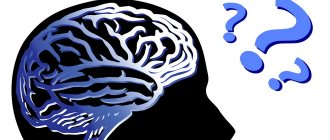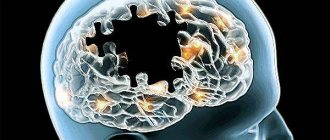Transcranial electrical stimulation or TES therapy refers to a technique for the therapeutic transcranial effect of pulsed currents on the human brain. This method was developed taking into account all the fundamentals of evidence-based classical medicine, so it is quite widely used and recognized.
TES therapy is based on the fact that special electrodes are attached to the patient’s head, through which a weak current is supplied. With this effect, electric current can have a protective effect on all functions of the brain and change its bioelectrical activity.
Mechanism of treatment with transcranial electrical stimulation
The therapeutic therapeutic effect of TES therapy is based on the ability to stimulate endorphin production processes in the human brain. During the procedure, the most sensitive and anti-pain structures in the brain are activated due to the ability of currents to penetrate soft tissue and bone.
Under the influence of transcranial currents, the production of endorphins is activated, they begin to concentrate in the blood, brain and cerebrospinal fluid. The hormone endorphin is capable of normalizing various disorders in the human body, while maintaining the natural course of normal processes without interfering with them. In addition, due to the increased production of endorphins, the patient has no pain during the procedure, which is explained by the ability of the hormone to relieve pain.
Content:
- Mechanism of treatment with transcranial electrical stimulation
- Main indications and contraindications of the technique
- Technique of TES therapy
- Equipment for transcranial electrical stimulation
The antidepressant effect of transcranial electrical stimulation is achieved by stabilizing the patient’s psychoneurological state, which also leads to a positive anti-stress effect, normalizes the patient’s sleep, improves his mood and increases his performance. This physiotherapeutic technique accelerates the healing of the skin and mucous membranes in the body, helps the regeneration processes of peripheral nerve fibers and liver parenchyma cells. TES therapy stimulates the immune system, slows down the growth processes of various (including malignant) tumors, and normalizes the physiological status in the human body.
The effect of the transcranial electrical stimulation procedure can be maintained in the body for several days, which gradually allows you to train the defense system. Thus, this technique trains the brain to actively produce endorphins on its own, and no addiction occurs during the procedure.
Transcranial electrical stimulation can be combined with therapeutic techniques such as:
- physiotherapy;
- balneological treatment;
- manual therapy;
- treatment with medications.
You cannot combine TES therapy with reflexology and morphine-like analgesics. The use of this technique systematically helps to reduce the consumption of pharmaceuticals, including hormonal agents, analgesics, and antidepressants with immunomodulators. According to the latest research, transcranial electrical stimulation is highly effective in treating all kinds of neurological pathologies, reducing their symptoms by 90%.
Conclusion after using the Doctor TES device
The expensive “Doctor TES” device, in my opinion, is not at all worth the money invested in itself. I did not feel the positive effects of use stated by the manufacturer on myself; moreover, during the course, negative effects were observed. Among other things, the long-term effects of the use of TES therapy are completely unknown, there are no studies on safety: for example, use for several years, and even more so in an even longer term. electrical stimulation of the brain to be irrational under these conditions .
Main indications and contraindications of the technique
There are quite a few areas of application for transcranial electrical stimulation. The most popular technique turned out to be for a variety of neurological and psychiatric pathological conditions, for example, for:
- depression, stress, sleep disturbances;
- hyperactivity, increased body fatigue, impaired attention;
- increased anxiety, chronic fatigue syndrome;
- menopausal neurosis, headaches of various origins;
- disorders of autonomic regulation, meteorological reactions;
- orofacial, phantom pain and pain in oncology;
- diseases of the sciatic nerves, as well as inflammatory processes of the trigeminal nerves;
- pain syndromes accompanying osteochondrosis, neuralgia, radiculitis;
- dyscirculatory encephalopathy, Parkinson's disease;
- motor disorders after a stroke.
Other pathological features that transcranial electrical stimulation can help combat include:
- coronary heart disease;
- painful sensations in the eyes, decreased vision, sensorineural hearing loss;
- various types of skin injuries and ulcers, including those that form in the postoperative period, as well as neurodermatitis, eczema, seborrhea (except for places where electrodes are applied);
- decreased immunity;
- the occurrence of neoplasms (except for the brain);
- toxicosis, allergies, inflammatory processes, disturbances in human hormonal levels;
- endometriosis, osteoarthritis, gastric and duodenal ulcers, duodenitis and gastritis;
- alcoholism and drug addiction.
TES therapy is also widely used in sports, since its effects significantly increase the effectiveness of training. This technique helps athletes withstand peak loads, restore their own strength, and improve performance.
Among the main contraindications for use in the treatment of transcranial electrical stimulation, experts identify the presence of epileptic seizures or convulsions, arterial hypertension, hypertensive crisis, hyperthyroidism, angina attacks, head injuries, brain injuries and the occurrence of tumors in the brain. In addition, such therapy cannot be carried out for thalamic pain, infections of the central nervous system, acute mental illness, hydrocephalus, atrial fibrillation, under the age of 5 years and with an implanted pacemaker.
Electrical brain stimulation improves mental performance, creativity and memory in healthy people
tDCS technology - transcranial direct current stimulation - has been studied for more than 20 years and has been successfully used in the clinic for recovery after stroke, treatment of depression and chronic pain. However, research over the past 6-7 years shows that it can also be beneficial for healthy people. A 2011 paper by Douglas Fox in the leading scientific journal Nature was the first to reveal to the general public that tDCS could improve learning, memory and risk-taking in healthy people. Since then, the number of studies on tDCS has grown steadily, opening up new areas of application for this technology.
Creativity and solving non-trivial problems
For example, a few months ago, scientists from Georgetown University in Washington published a study showing that tDCS improves creative thinking. Participants in the experiment - healthy young people with a similar education and level of intelligence - had to find associative connections between different sets of words. And those of them who were subjected to electrical stimulation found much more non-trivial analogies.
The ability of tDCS to increase creativity has been studied for over 5 years. In 2012, a group of Australian scientists from the University of Sydney discovered that tDCS helps solve complex, previously intractable problems. A test was used that most people are unable to cope with: connect 9 dots with 4 lines without lifting your hands. None of the participants was able to solve the task before stimulation, but tDCS led to the fact that 40% (!) of the subjects were able to find the correct answer.
Research is also being conducted on the effect of tDCS on the ability to solve mathematical problems. In 2010, researchers from the Institute of Cognitive Neuroscience in London conducted an experiment in which healthy volunteers performed math operations on fictitious symbols representing the numbers 1 to 9. It turned out that tDCS promoted faster learning of new symbols and led to better results in solving problems, and the effect of stimulation lasted for six months.
How does tDCS work?
The mechanism underlying the action of tDCS is quite simple. Electrodes are applied to the head, through which a weak constant current (1-2 milliamps) passes, affecting certain areas of the brain. The current strength is too low to activate the neurons. However, it still significantly changes their physiological state, making them more or, conversely, less prone to activation, depending on the type of influence.
The ability of neurons to fire depends on the potential difference across their membrane; This is what tDCS changes. In the case of a positive charge on the electrode (“anode”), the potential difference decreases, which increases the probability of excitation of the neuron in the event of an external signal. In the case of a negative charge of the electrode (“cathode”), the excitability of neurons, on the contrary, decreases.
In order to obtain the desired effect (for example, increase math ability or reaction speed), it is necessary to correctly select brain areas and place electrodes with the appropriate charge on them. The applications of tDCS are very diverse, and, in fact, are limited only by knowledge of the functions of various areas of the brain.
Learning and Memory
In 2010, a New Mexico research group conducted a high-profile study showing that tDCS accelerated learning “DARWARS Ambush!” - a video game designed specifically for training American soldiers. People scan virtual landscapes for obstacles, such as the shadow cast by a sniper or an improvised explosive device, and must react to them as quickly as possible. It turned out that volunteers who were exposed to tDCS during training showed better results. tDCS is also mentioned in another US Military study. In 2011, it was reported that electrical stimulation successfully improved the learning ability of American pilots undergoing training on video simulators.
More than 10 studies show that tDCS increases the effectiveness of foreign language learning. For the “purity” of the experiment, volunteers studied fictitious languages. It turned out that after tDCS they remembered new words better, and their speech also became more fluent.
Addictions
Another interesting possibility of electrical stimulation is the reduction of addictions, for example, from tasty food. In a study by German scientists led by Kerstin Oltmans, a group of healthy volunteers received tDCS sessions every day for a week and watched how this changed the number of calories they consumed. To do this, they were misled about the essence of the experiment - the subjects thought that the effect of tDCS on mood was being studied. And before and after the test, a table was set for them, ostensibly to thank them for their participation. However, the amount of calories consumed was strictly monitored, and it turned out that after a week of stimulation it decreased by as much as 14%. According to the researchers, this happened not so much due to a decrease in appetite, but rather due to the development of willpower and making more rational decisions. Therefore, it is not surprising that tDCS also helps with other addictions - nicotine, alcohol, marijuana and even cocaine.
Depression
tDCS has also been successfully used to treat depression. Moreover, electrical stimulation is effective even in the case of severe forms - acute and resistant. The mechanism by which tDCS combats depression appears to have much in common with the effects of antidepressants. As a result, tDCS stimulates the production of “happiness hormones” - endorphin and serotonin. However, unlike antidepressants, tDCS is not associated with side effects such as nausea and insomnia.
Empathy, risk and safe driving
It is impossible to describe all the effects of tDCS within the scope of this article - they are so numerous and varied. Therefore, let’s finally talk about the most unexpected ones. For example, electrical stimulation improves people's social skills - increasing empathy and the ability to put oneself in the shoes of others. In one study, healthy volunteers played a game where they had to move an item that a virtual character on the screen asked them to do. However, he saw the room from a different angle than the person in front of the screen (for example, he saw only part of the closet), and this had to be taken into account when completing the task. For example, when asked to move the largest candle, the player had to choose the largest candle that the character could see. It turned out that after tDCS, the correctness of task completion increased by 33%.
In other work, tDCS made subjects less vindictive. Volunteers took part in the famous Ultimatum game. Its essence is that one of the participants must divide $10 between himself and the second participant, and the second participant, having received the money, must decide whether he will take it or not. If he refuses, no one receives any money, but if he agrees, he receives the offered share. It is known that a lot of people refuse money if they think that there is too little of it, because they see it as unfair and want to punish the first participant. However, after tDCS, people were much more likely to agree to a smaller amount.
Studies have been conducted in which tDCS reduces people's risk taking and promotes safer driving styles, increases awareness of the present moment and promotes greater immersion in virtual reality worlds. There are even exotic studies that tDCS reduces tinnitus, clears the mind of false memories and expands the frequency spectrum of perceived sound.
Electrical brain stimulation: is there a danger?
During electrical stimulation, the brain is exposed to a very weak current - only 1-2 milliamps. This is about the same amount as a firefly spends to glow. And in principle, the procedure is quite safe. There are no serious side effects with it (and more than 12,500 scientific articles have already been published on the topic) - sometimes only itching in the skin in the area where the electrodes are attached, tingling, burning and a feeling of discomfort, in rare cases - headache. There is, however, a risk that improving some brain functions will lead to deterioration in others. For example, in one of Cohen Kadosh's studies, brain stimulation helped subjects memorize a system of symbols that had numerical correspondences (for example, chicken = 1, egg = 5), but they had more difficulty using this knowledge in another task, compared with subjects who memorized everything. without stimulation.
Additionally, it must be kept in mind that the effect of tDCS is highly dependent on the brain region being stimulated and the task the brain is required to perform. In the case of an incorrectly selected area of the brain and type of influence (electrode polarity), the effect may well become negative.
Startups
After a surge in research on tDCS, startups began to appear in America creating electrical stimulators for healthy people. The first of them was “foc.us”, which initially offered devices to gamers, but then included people involved in sports in the target audience. Then the startups Apex and PriorMind appeared. There are reports that another American startup, Thync, has raised $13 million to develop its device. There are such startups in Russia, for example, Brainstorm.
Technique of TES therapy
Before using transcranial electrical stimulation to treat any disease, it is necessary to consult a physiotherapist and a neurologist. Therapy should not be performed immediately after eating; the interval between eating and the session should be at least two hours.
During TES therapy, the patient needs to lie down or sit, and the specialist places electrodes on the patient’s forehead, on the back of the head and on the nipples. Before applying the electrodes, the patient's skin is thoroughly cleaned and checked for damage, formations or rashes.
Ear jewelry should be removed during TES therapy. During the procedure, the patient may feel a slight vibration, tingling in the area where the electrodes are applied, and may also observe light flickering with their eyes closed. Electrodes do not leave marks on the skin.
To carry out the manipulation, special pulsed low-amplitude currents with a rectangular bipolar pulse shape are used. During the first procedure, the minimum current reading should be used, which should not be increased even if the patient does not have any third-party sensations. In subsequent sessions, the current levels are gradually increased until the patient begins to feel their presence. If discomfort is detected, the specialist should reduce the supplied current. Gradually, towards the end of the procedure, the current strength should be reduced to zero.
The patient should experience the above sensations, but they should not be unpleasant to him. In this way, the optimal current strength is regulated, and if it bears fruit in the form of positive results, then during further sessions the specialist will use exactly this current, without changing it upward.
If the patient has severe pain, then similar procedures can be performed several times a day with an interval of at least 4-6 hours. If the pain does not disappear, the patient is advised to undergo additional medical consultation and examination.
Currents affect the alpha rhythms of the human brain at a frequency of 70-80 hertz, stimulating the production of endogenous opioid peptides. After the session, those who suffer from blood pressure disorders are advised to rest for fifteen minutes and undergo a neck-collar massage. The duration of one procedure of transcranial electrical stimulation is 20 minutes, although in case of severe pain this time can be increased. The course of therapy usually includes about 15 sessions. In case of exacerbation of chronic diseases, TES therapy is aimed at relieving emerging symptoms, which can be done in 5 procedures. In 1 calendar year, it is permissible to conduct up to 60 sessions, repeating courses every 2-3 months.
How to prepare for the procedure
No specific preparation is required, which allows transcranial stimulation to be performed on patients of various age categories.
During the preliminary conversation, the patient is told how the procedure will go. The course of treatment is usually 5-9 sessions.
The procedure is prescribed after examination by a doctor and certain studies. To exclude acute conditions, the following is performed:
- blood pressure measurement;
- temperature measurement;
- sometimes electrocardiography.
TES of the brain in obstetrics and gynecology
It is no longer a secret that applying electric current to the human brain can cure a large number of diseases. Transcranial electrical stimulation in gynecology is indicated for the treatment of pathologies of the reproductive system in women:
- For disorders of the female genital area, for example, dysfunctional uterine bleeding.
- Chronic inflammatory processes of the genital organs in women, such as subacute adnexitis and colpitis.
- For urinary incontinence.
- In case of miscarriage.
- To enhance orgasm.
- To reduce the diameter of the vagina, which was stretched during labor.
But this method of therapy can be used in the treatment of not only adults, but also children. Thus, transcranial electrical stimulation is used for children with speech disorders and other conditions.
Definition and a little history
With the development of science, people began to become increasingly interested in the concept of animal electricity. Luigi Galvani conducted experiments in which, using electrical impulses, he caused the muscle tissue of a frog to contract. Later, many other scientists began to conduct similar experiments.
The strong minds of mankind have always been interested in what properties muscles have. Therefore, many experiments were carried out. One of the most striking was an experiment in which the muscles of a dead body were forced to contract using electric current.
The development of electrical equipment has made it possible to obtain magnetic fields using current and vice versa. This is how the idea arose to use magnetic fields rather than electricity to stimulate the cerebral cortex. This is how a method emerged that was later called “transcranial magnetic stimulation of the brain.”
Scientifically, this procedure is defined as a method that allows stimulation of parts of the cerebral cortex using a magnetic field without pain at a certain distance. The brain responds to this influence in the form of short impulses. This technique is suitable for the diagnosis and treatment of many diseases.









